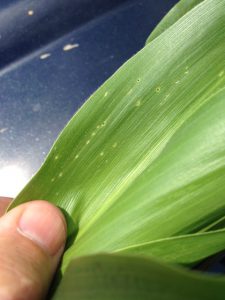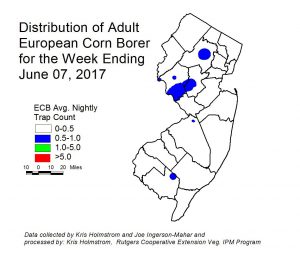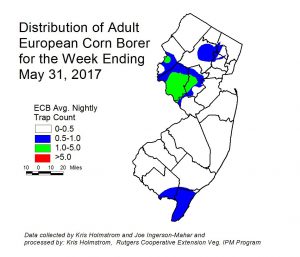Sweet Corn
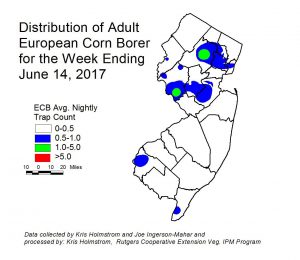 European corn borer (ECB) catches have stabilized, with significant catches remaining in central Morris County and in southern Hunterdon County (see ECB map). Feeding in NJ sweet corn plantings is increasing in occurrence, although severity of individual infestations has not risen dramatically. Overall, activity is lower than expected this year, likely due to adverse weather conditions. Feeding rates in the 20% range are common. Check 5 plants each in 10 random locations for a 50 plant sample. Look for “shot-hole” injury, and consider treating when the number of infested plants in a 50 plant sample exceeds 12%. As infested plants proceed to the pre-tassel stage, live larvae and damage may be found in the emerging tassels (see bottom photo at right). Once plants hit full tassel, ECB larvae will move downward on the stalk and re-enter the plant near the area where ears are forming. This can result in direct injury to the ear. Growers should consider an insecticide application at the full tassel stage to target ECB larvae as they migrate downward. This application can eliminate larvae that have escaped
European corn borer (ECB) catches have stabilized, with significant catches remaining in central Morris County and in southern Hunterdon County (see ECB map). Feeding in NJ sweet corn plantings is increasing in occurrence, although severity of individual infestations has not risen dramatically. Overall, activity is lower than expected this year, likely due to adverse weather conditions. Feeding rates in the 20% range are common. Check 5 plants each in 10 random locations for a 50 plant sample. Look for “shot-hole” injury, and consider treating when the number of infested plants in a 50 plant sample exceeds 12%. As infested plants proceed to the pre-tassel stage, live larvae and damage may be found in the emerging tassels (see bottom photo at right). Once plants hit full tassel, ECB larvae will move downward on the stalk and re-enter the plant near the area where ears are forming. This can result in direct injury to the ear. Growers should consider an insecticide application at the full tassel stage to target ECB larvae as they migrate downward. This application can eliminate larvae that have escaped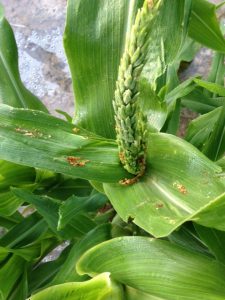 any earlier insecticide applications. [Read more…]
any earlier insecticide applications. [Read more…]
